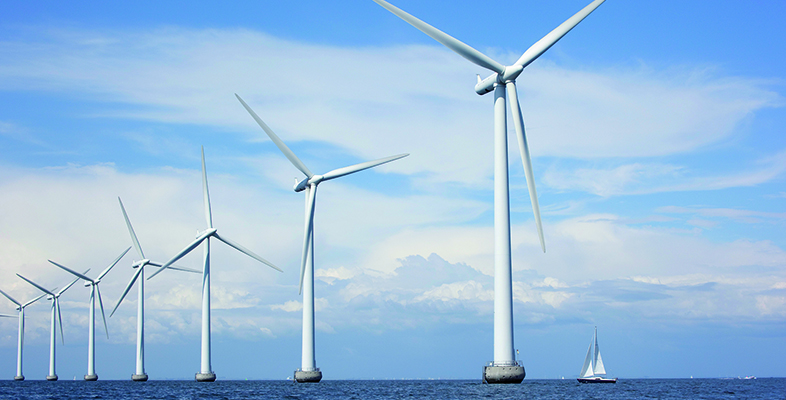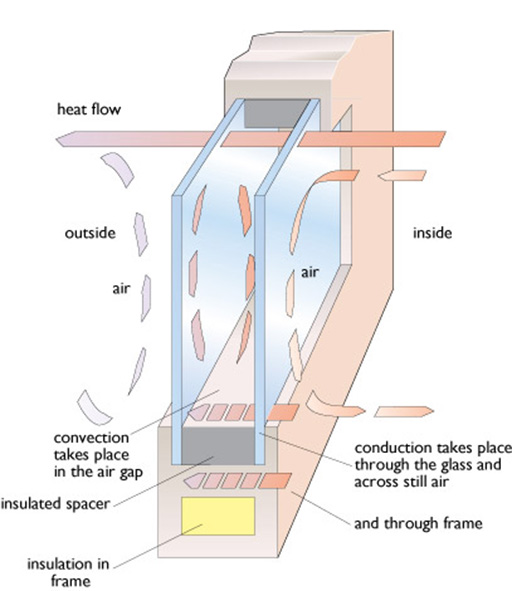2.2.1 Insulated windows
Figure 5 shows a cutaway diagram of a double-glazed window. This may take the form of a single-glazed window plus a separate extra pane of secondary glazing or, more commonly, a sealed double-glazing unit, usually with a space between the panes of about 16 mm. However, the basic principles are the same.
Conduction
In any material, heat energy will flow by this mechanism from hotter to colder regions. The rate of flow will depend on the area and temperature difference, and on the thermal conductivity of the material, a topic that will be discussed in more detail later.
Generally, metals have very high thermal conductivities and can transmit large amounts of heat for small temperature differences. In a window, heat conduction takes place through the frame, which may be made of wood, plastic or metal. In high-quality windows, frames often include an insulated thermal break to minimise heat loss. Further heat conduction takes place through still air within the window but this is limited because still air is a good thermal insulator. Insulators require a large temperature differential to conduct a relatively small amount of heat.
Most practical forms of insulation rely on very small pockets of trapped air, for example between the panes of glazing, as bubbles in a plastic medium, or between the fibres of mineral wool.
Convection
While still air is a good insulator, moving air can carry heat from a warm surface to a cooler one. A warmed fluid, such as air, will expand as it warms, becoming less dense and rising as a result, creating a fluid flow known as convection. This is one of the principal modes of heat transfer through windows. It occurs between the air and the glass on the inside and outside surfaces, and, in double-glazing, in the gas trapped between the panes. The convection effects can be reduced by filling double-glazing with heavier, less mobile gas molecules. Argon is most commonly used; the heavier gases krypton and xenon give better performance but are more expensive. These gases are all by-products of the industrial liquefaction of air to produce oxygen.
Convection can also be reduced by limiting the space available for gas movement. This is the principle used in most insulation materials.
Various forms of transparent insulation have been developed that use a transparent plastic medium containing bubbles of trapped insulating gas. These materials could eventually revolutionise the construction of windows and walls, but at present the materials are expensive, not robust and need protection from the rigours of weather and ultraviolet light.
Alternatively the glazing can be evacuated. Convection currents cannot flow in a vacuum. However, a very high vacuum is required and it needs to last for the whole life of the window, which may be 50 years or more. Also the window will need internal structural spacers to stop it collapsing inwards under the air pressure on the outside. These spacers conduct heat across the gap, slightly reducing the overall performance. The vacuum gap does not need to be very thick and is only 0.2 mm wide in commercial vacuum double-glazing units.
Note that these convection currents are only concerned with what happens inside a double-glazing unit. There are also likely to be movements of air through the seals around the edges of windows, but that is a matter of ventilation and infiltration (see Section 2.3).
A simpler way to reduce the convection effects is to insert extra panes of glass or transparent plastic film between the panes of double-glazing turning it into triple- or quadruple-glazing.
Radiation
Heat energy can be radiated, in the same manner as it is radiated from the sun to the earth. The quantity of radiation is highly dependent on the temperature difference between the radiating body and its surroundings. The roof of a building, for example, will radiate heat away at night to the cold atmosphere. In a double-glazed window heat will be directly radiated from the inner pane across the gap to the outer one.
The amount of radiation also depends on the surface’s emissivity. Most materials used in buildings have high emissivities of approximately 0.9, that is, they radiate 90% of the theoretical maximum for a given temperature. Other surfaces can be produced that have low emissivities. This means that although they may be hot, they will radiate little heat outwards. ‘Low-e’ coatings are now normally used inside double-glazing to cut radiated heat losses from the inner pane to the outer one across the air gap. There are two basic types. ‘Hard coat’ uses a thin layer of tin oxide, giving an emissivity of 0.15–0.2. ‘Soft coat’ uses very thin layers of optically transparent silver sandwiched between layers of metal oxide and gives an emissivity of 0.05 or better.

